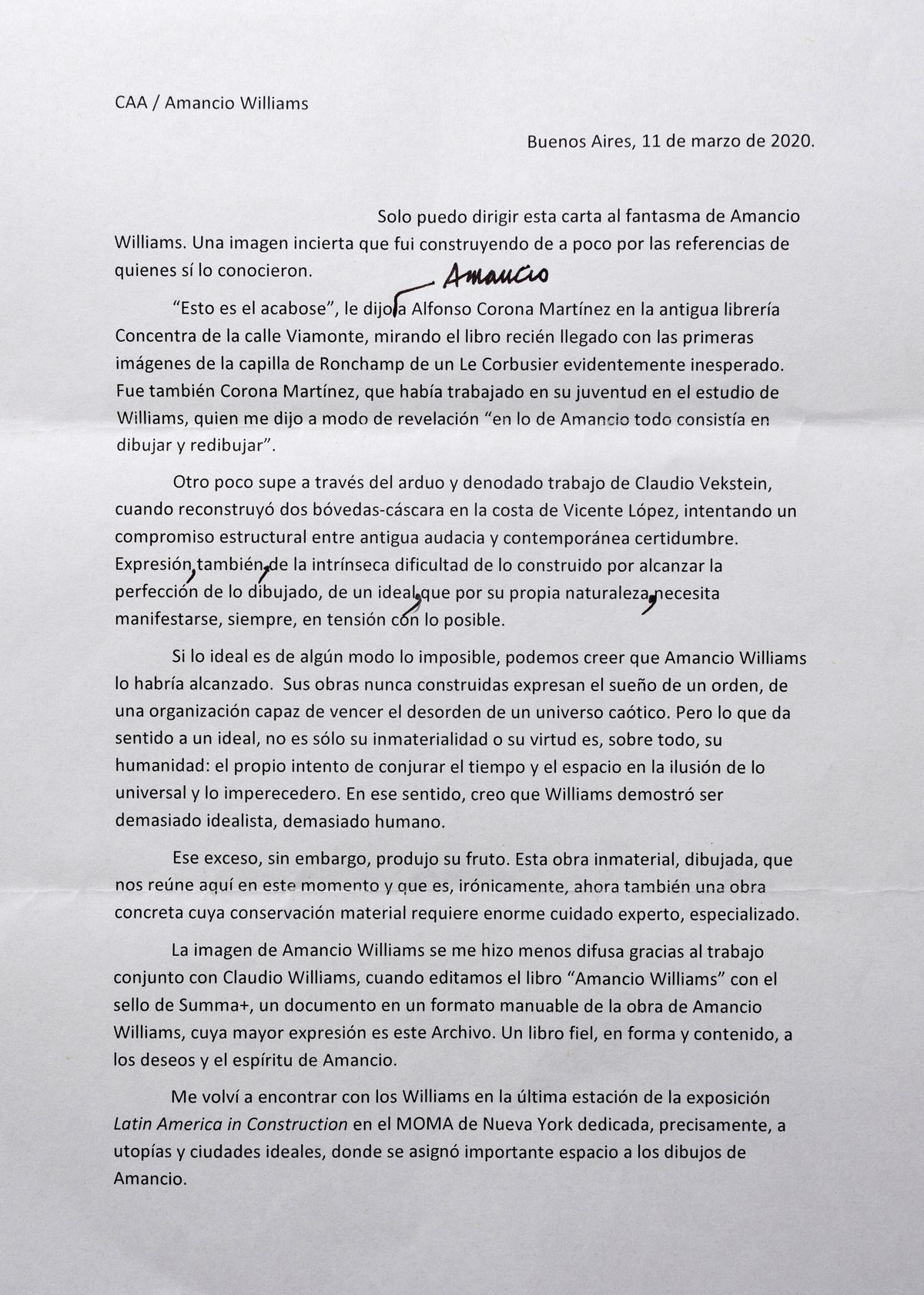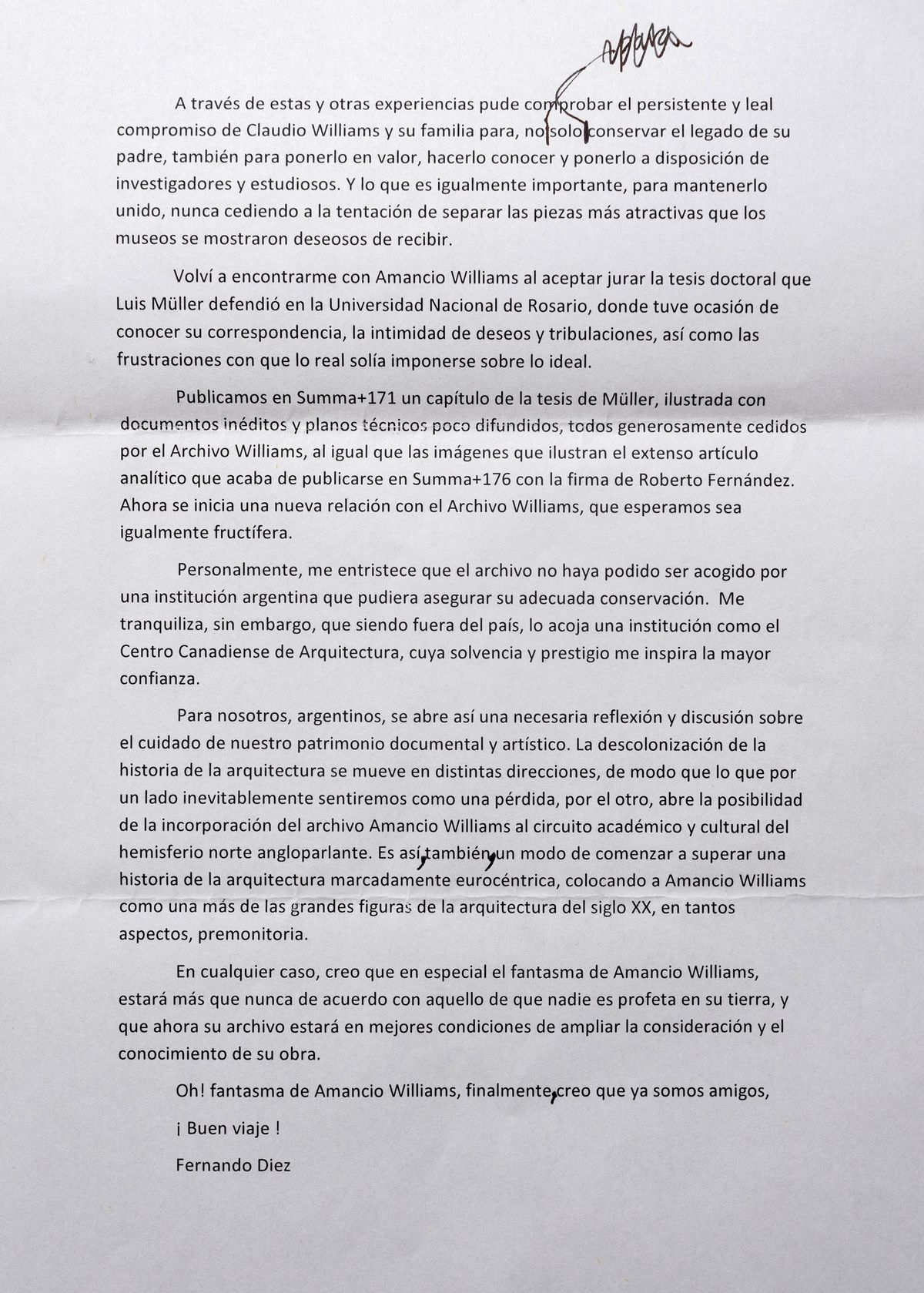I can only address this letter to the ghost of Amancio Williams. An uncertain image that I pieced together from the stories of those who did know him.
“This is the end,” Amancio had said to Alfonso Corona Martínez, in the old Concentra bookshop on Calle Viamonte, while looking at a recently arrived book with the first pictures of Ronchamp Chapel by an obviously unexpected Le Corbusier. It was also Corona Martínez, who had worked in Williams’s studio in his youth, who told me, by way of revelation, that “everything in Amancio’s work was about drawing and redrawing.”
I learned a little more through the diligent, undaunted work of Claudio Vekstein when he reconstructed two shell vaults on the coast of Vicente López, seeking a structural compromise between age-old audacity and contemporary certainty. An expression, too, of the intrinsic difficulty for built work of achieving the perfection of the drawing, of an ideal which, by its very nature, necessarily manifests itself in tension with the possible.
If the ideal is, somehow, the impossible, we might think that Amancio Williams could have achieved it. His unbuilt works express the dream of an order, of an organisation capable of overcoming the disorder of a chaotic universe. But what gives meaning to an ideal is not just its immateriality or its virtue; it is, above all, its humanity: the very attempt to conjure time and space in the illusion of the universal and the imperishable. In this sense, I think that Williams proved to be too idealistic, too human.
This excess, nonetheless, bore fruit: the immaterial drawn work that brings us together here, at this moment—now, ironically, also a concrete work, the material conservation of which calls for expert, specialized care.
The image of Amancio Williams became less vague to me thanks to my joint work with Claudio Williams editing the book Amancio Williams, published by Summa+, a document in a handy format containing the work of Amancio Williams, the ultimate expression of which is this Archive. A book that is faithful, in form and in content, to the wishes and the spirit of Amancio.
I encountered the Williamses once again in the final section of the exhibition Latin America in Construction at the MOMA in New York, dedicated, precisely, to utopias and ideal cities, where considerable space was set aside for Amancio’s drawings.
Through this and other experiences, I was able to verify the persistent, loyal commitment of Claudio Williams and his family not just to conserving the legacy of his father, but also promoting it, making it known and available to researchers and scholars. And, just as importantly, to keeping it together, never yielding to the temptation to separate out the most attractive pieces that museums were eager to receive.
I encountered Amancio Williams again when I agreed to review the doctoral thesis that Luis Müller defended at the National University of Rosario, where I had the opportunity to become familiar with his correspondence, his personal desires and tribulations, and the frustration of the real that tends to prevail over the ideal.
In Summa+ 171, we published a chapter of Müller’s thesis, illustrated with hitherto unpublished documents and little-known technical plans, all generously loaned by the Williams Archive, and the images that illustrate the extensive analytical article by Roberto Fernández published in Summa+ 176. Now begins a new relationship with the Williams Archive, which we trust will be just as productive.
Personally, it saddens me that it has not been possible to place the Archive in the care of an Argentinian institution that could ensure its appropriate conservation. I am reassured, however, that despite leaving the country, it is in the safekeeping of an institution like the Canadian Centre for Architecture, whose reliability and prestige deserve the greatest confidence.
For us, Argentinians, this prompts necessary reflection and discussion about the care of our documental and artistic heritage. The decolonization of the history of architecture is moving in different directions: what we inevitably feel as a loss at the same time represents the possibility of incorporating the Amancio Williams Archive into the academic and cultural circuit of the Anglophone northern hemisphere. It is, then, also a way of starting to overcome a markedly Eurocentric history of architecture, placing Amancio Williams in the realm of the great figures of twentieth-century architecture, prescient in so many ways.
In any case, I think that the ghost of Amancio Williams, in particular, will agree, more than ever, with the old adage that no one is a prophet in their own land, and that now, his Archive will be better placed to promote the knowledge and appreciation of his work.
So, ghost of Amancio Williams, I finally think that we are now friends.
Bon voyage!
Fernando Diez
Buenos Aires, 11 March 2020

